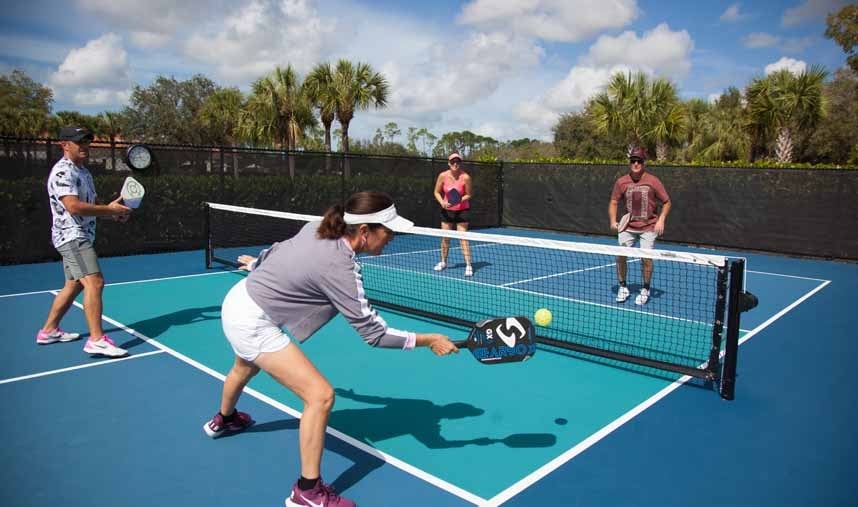Checking Out the Numerous Choices for Backyard Pickleball Courts: A Property owner's Guide to Installation and Upkeep
As the appeal of pickleball continues to climb, several house owners are considering the installation of a devoted court in their yards. What are the ideal methods to ensure your court remains beautiful and functional over time?
Reviewing Your Space
When taking into consideration the addition of a pickleball court to your yard, how can you successfully examine the offered area? The first step is to measure the dimensions of your yard, guaranteeing that you have enough area for a regulation-sized court, which gauges 20 feet by 44 feet for doubles play (backyard pickleball court). It's essential to make up added room surrounding the court to promote motion and boost gameplay, usually advising an additional 10 feet on each side
Next, review the terrain of your yard. A level surface area is suitable for a pickleball court, as irregular ground can lead to security risks and influence gameplay. If your yard slopes or has obstructions such as trees or landscape design attributes, think about exactly how these elements will influence your court's area and usability.
Picking Court Surfaces
Picking the best surface for your backyard pickleball court is critical for maximizing efficiency and gamer safety. The choice of court surface not only affects gameplay but also affects the sturdiness and maintenance of the court.
Asphalt and concrete offer a hard, resilient surface that can tear and stand up to the wear of normal play. To mitigate this, many homeowners decide for cushioned surface areas or specialized finishes that offer some level of shock absorption.
Alternatively, modular sporting activities ceramic tiles are a progressively preferred choice. These floor tiles are developed specifically for pickleball and offer exceptional traction, water drainage, and shock absorption. They can also be mounted over existing surface areas, making them a flexible alternative for numerous yards.
When picking a surface, think about variables such as climate, spending plan, and desired level of play. A well-chosen court surface area will enhance your playing experience while ensuring security and longevity for your backyard pickleball court. Making an educated decision is essential for maximizing satisfaction and performance.
Setup Process Summary
Mounting a yard pickleball court usually includes numerous key actions that make certain both functionality and durability. The initial step is to choose a suitable area in your lawn, considering variables such as proximity, sunlight, and drain to your home. Once the website is chosen, clear the area of any type of greenery, rocks, or particles to create a degree structure.
Next, outline the dimensions of the court, which should be 20 feet wide by 44 feet long for a typical pickleball court (backyard pickleball court). After marking the boundaries, excavate the area to a depth of about 4 to 6 inches, ensuring appropriate water drainage. This excavation will enable a steady sub-base
Following this, mount a base layer of crushed rock or crushed stone to promote water drainage and security. Portable this layer thoroughly before proceeding. After the base is established, you can put a concrete slab or install your selected court surface area materials, ensuring they stick to the measurements.
Maintenance Tips and Strategies
To make sure the long life and performance of your backyard pickleball court, regular upkeep is essential. Use a mop or fallen leave blower to maintain the court tidy, eliminating leaves, dirt, and other debris that can influence gameplay.

Furthermore, check your court's drain to protect against water pooling, which can lead to surface area damage in time. Make sure that the bordering landscape routes water far from the court. Take into consideration securing the surface area every couple of years to enhance longevity. if your court is made of asphalt or concrete.
Lastly, establish a routine timetable for discover here upkeep jobs, consisting of seasonal checks and repair services, to keep your court in linked here optimal problem and prepared for play. Regular upkeep not just improves performance yet also lengthens the life of your backyard pickleball court.
Expense Considerations and Budgeting
When preparing for a backyard pickleball court, understanding the various cost considerations is vital for efficient budgeting. The total expenditure can differ significantly based on factors such as court dimension, surface area material, and installment complexity.
First prices generally consist of site preparation, which might involve grading and leveling the land, followed by the choice of surface-- options range from asphalt to concrete, with each material impacting both lasting and upfront prices. Concrete gives resilience but comes with a greater rate tag, while asphalt may use a much more economical option.
Additionally, think about the prices related to fence, lighting, and accessories such as nets and paddles - backyard pickleball court. Fencing is essential for keeping spheres had, and lighting can prolong play right into the evening hours

Verdict
To conclude, the installation of a yard pickleball court involves mindful factor to consider of space, surface area materials, and upkeep requirements. Choosing appropriate measurements, such as the suggested 20' x 44', along with sturdy surface options like asphalt, concrete, or modular sporting activities ceramic tiles, contributes to a functional field. Routine upkeep and tracking for wear are necessary to guarantee the court's long life and ideal efficiency, eventually enhancing the entertainment experience for all individuals.
A level surface area is optimal for a pickleball court, as uneven ground can lead to safety and security dangers and impact gameplay. A well-chosen court surface area will enhance your having fun experience while making sure safety and durability for your backyard pickleball court.Next, describe the dimensions of check here the court, which need to be 20 feet large by 44 feet long for a common pickleball court. After the base is established, you can put a concrete piece or install your chosen court surface products, ensuring they stick to the dimensions.
In final thought, the setup of a yard pickleball court involves cautious factor to consider of area, surface products, and maintenance needs.